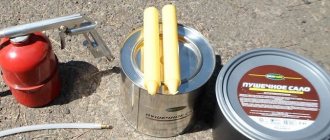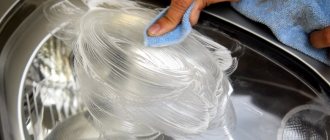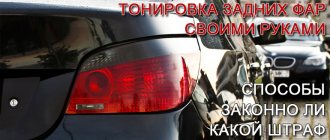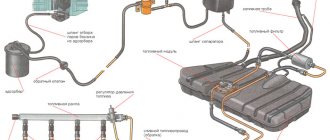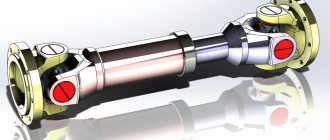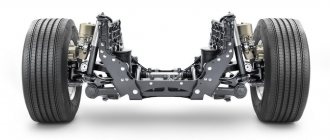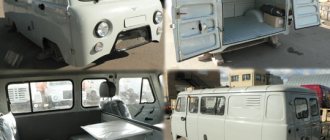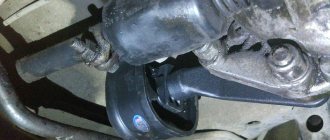Introduction. Due to numerous requests, I photographed the pneumatic system. It is easy to assemble, all the fittings cost 1000 rubles + 1300 for a set of them from Leroy. Budget.
PVC or cannon fat. A mythical anticorrosive agent that everyone has heard about, but is not made anywhere.
There was no question of whether or not to do anticorrosive. There was also no question of whether to go to the service or not. They won't do anything good there. The question was what to do. I usually use RAST-Stop, but suddenly it went out of stock until December. All dinitrols are expensive and not trustworthy. Tektil is even more expensive. Movili leaks, sprays poorly and is not very anticorrosive.
All that's left is fluff. The process required a pneumatic system (see previous topic) and a lot of dancing with a tambourine to bring it to the desired state of aggregation.
First you need to dress correctly:
And prepare the kitchen corner. A gas stove (especially for family people), as well as the proximity of housing, is categorically not recommended, in order to avoid multiple blunt injuries.
Next, the push salo must be heated in a water bath if you do not want to be nominated for a Darwin Award. Also, never use gasoline as a solvent. The inscriptions on PVK cans are made solely to mislead the enemy.
Gasoline is highly volatile, flammable and toxic. Use white spirit. You won't get poisoned by it. But a gas mask is highly desirable.
We dilute the mixture: 2 kg pushsal 2 liters of white spirit 200 ml. oils (do not use waste, you don’t eat rotten meat? Why should a car?)
We heat it all up until the pushsal is completely dissolved naturally (without intensive stirring). You will have to heat it the entire time of processing (several hours), so a supply of fuel and a reliable stand for a bucket of water, which we will heat, are required.
The pistol should also be prepared. Place a hose with a diameter of 13 mm onto the spout. about 20 cm long. A very long or thin one will greatly degrade the spray quality. And treat all open surfaces without a hose at all. The spray pattern is amazing.
Next, we warm up the gun with a hairdryer, pour in 500 grams of the solution and, until it cools down, blow it wherever we can reach.
2 kilograms of lard is enough to cover all the hidden cavities and bottom accessible from below. And there's still enough for the frame.
The cover of the pushsalo is very unusual.
It doesn't flow unless you water it with a hose. Once on the surface, the solution cools sharply and becomes viscous. And it lies where they put it. Very comfortably.
The spray was so good that I found traces of the treatment under the upholstery of the front pillars! And the outside of the whole car was covered with a thin layer of anticorrosive. I scrubbed for 3 hours.
The remains can be used to protect, for example, the seams on the roof under the rubber bands. Unlike many compounds, rubber does not deteriorate.
The car is assembled, washed, smiling and ready to take the co-driver to competitions.
Almost any car owner, having locked the car and walked some distance, will definitely turn around to once again admire his car and evaluate its condition.
The car is constantly exposed to aggressive environmental influences. The main enemy is moisture - the cause of rust.
To protect against it, machine parts must be treated with an anti-corrosion coating. The car care market offers many options. One of the most popular is treating a car with cannon fat.
Treating a car with cannon fat: instructions
The process of treating a car with cannon fat is quite simple, but it is important to follow some safety requirements and also acquire a number of tools. To apply the substance to the car body you will need:. Cannon fat
In stores you can most often find this substance in containers from 2 to 5 liters. On average, it takes about 1 liter of substance to treat one car;
Cannon fat. In stores you can most often find this substance in containers from 2 to 5 liters. On average, it takes about 1 liter of substance to treat one car;
- Heat source. A regular electric stove, gas burner or something similar can be used here. A heat source is needed to heat the cannon fat;
- Tara. If you do not plan to use a full container of cannon lard, you will need to get a container in which you can heat the required amount of the substance;
- Degreaser. In this case, you can use regular white spirit;
- Application medium. This could be a brush, a paint gun or something similar;
- Sandpaper. If there are elements of corrosion on the car, you will need sandpaper to clean them off first.
Important: Before starting work, be sure to remove the fire extinguisher from the car and place it in a visible place. Since the work involves the use of heating elements, there is a risk of fire
Having prepared the necessary tools, you can proceed to work:
The first step is to heat the cannon fat to a liquid state. This substance melts at a temperature of about 90 degrees Celsius
It is recommended to use an electric stove to heat the substance, so as not to use an open fire, since the powder ignites easily; Please note: Before heating, it is recommended to add 10-20% of the volume of gasoline to the cannon lard in order to obtain a homogeneous mass during heating. It is also necessary to stir it constantly while heating the substance. You will also need to prepare the car for application of the substance.
To do this, it is recommended to remove all plastic elements that may interfere with the work. It will be necessary to clean the dirt from and dry the body parts to which the spray will be applied. If there are any signs of corrosion, remove them with sandpaper. When the body is prepared, degrease it using white spirit or another similar product;
Next, proceed directly to the process of applying cannon lard. You can use any convenient tools for this, but the easiest way to do the job is with a brush. When using a brush, use broad strokes to distribute the product evenly throughout the body.
You can apply cannon fat into hidden cavities using a syringe; Please note: If you use a sprayer to apply gun lard, you can add used machine oil to it while heating the substance to control the thickness
Once the substance is applied to the car, wait about an hour for it to dry before putting the plastic parts back on.
The main advantage of gun lard over other anti-corrosion mastics is its long service life. After treating the body with pushsal, at least 4 years will pass before you have to apply the substance again, while conventional mastics need to be replaced every 1.5-2 years.
There is also a drawback to cannon lard - its stickiness. Even after hardening, road dirt sticks quite strongly to the substance, but this problem can be solved by washing.
>
What will you need?
To apply this anti-corrosion protection, you will need to prepare some equipment. This list is small and contains almost all the elements available in the garage of a self-respecting car enthusiast. So, you will need:
- Cannon fat
. It is usually sold in 2 or 5 liter buckets. It usually takes about a liter to treat a passenger car; - Electric stove
, you will need it to heat up the lard. If it is absent, then any other heat source can be used; - Container for heating
. Sometimes they heat it directly in a bucket. It makes sense to do this in case of complete use of the substance; - Degreaser
. White spirit will do; - Brush
, paint gun or old syringe for lubricating parts.
In addition, sandpaper may be required to remove rust. Just in case, place a fire extinguisher in a visible place.
Requirements for anti-corrosion coating
The correct anticorrosive agent must have the following properties:
- Form an elastic film on a metal surface.
- Possess a high degree of adhesion - adhesion of various surfaces in solid or liquid form.
- Impregnate not only smooth surfaces, but also penetrate into cracks and depressions.
- Displace accumulated moisture.
- Wet the surface well.
- Should not dry out.
- Do not form cracks where water can penetrate.
- No special surface preparation is required.
- Be resistant to the mechanical effects of small particles rising from the road surface - gravel, sand, pebbles.
- Be resistant to temperature changes and maintain its characteristics at any time of the year.
The use of cannon tallow satisfies these requirements and creates reliable insulation from the environment. The composition of cannon lard is petroleum oil, which is thickened with petrolatum and ceresin. To ensure performance properties, an anti-corrosion additive is added.
The coating received its name due to the fact that it was first used to preserve artillery weapons, including guns.
Benefits of cannon lard
Main features of the substance:
- high degree of elasticity;
- ability to stay on the surface without rolling off during application and further use;
- lack of interaction with water, which allows it to be successfully used on the bottom of a car;
- temperature range of use – from minus 50° to plus 50°C;
- protection against corrosion when exposed to sea water and salt fog;
- Application area: ferrous and non-ferrous metal surfaces.
Visually it is a homogeneous ointment-like mass with a color ranging from yellow to light brown. Sold in metal cans or buckets of various capacities. Packaging starts from 1 kg.
The price of this type of anti-corrosion coating is very affordable. For comparison, the table shows the cost depending on volume and manufacturer.
Preparation
Before applying the coating, you should prepare everything you need. To carry out anti-corrosion treatment you will need:
- cannon fat in a jar or bucket;
- breeding agent;
- electric stove or hair dryer;
- paint brush;
- syringe.
We should especially talk about the breeding agent. There are several options for diluting cannon fat to a liquid state.
For this the following can be used:
- petrol;
- solvent;
- used oil;
- Movil;
- anti-corrosion agent like RUST STOP.
Each of them has its own disadvantages and advantages. The solvent will cost a little more. The processing properties depend on what kind of oil was originally used.
Anti-corrosion agent RUST STOP is one of the substances that successfully fights metal corrosion. Manufacturer: Canadian.
The advantage of RUST STOP is that it never freezes. Being in a semi-liquid state, this product fills all cracks and scratches on the metal surface without damaging the rubber parts. A layer of corrosion inhibitors reliably protects the surface from rust.
This anti-corrosion agent does not require particularly careful preparation of the surface to be treated - it can be applied over a slight layer of rust. As a result, the anti-corrosion treatment technology is significantly simplified and the time for the entire process is reduced. An additional bonus is that the manufacturer uses various fragrances, for example, cherry or strawberry.
Mode of application
First you need to prepare the car. It is necessary to remove all plastic parts that interfere with operation. Rinse the surfaces that will be protected. Remove traces of corrosion. Degrease the surface by wiping it with white spirit.
Then you should prepare the cannon fat. This work consists of heating it and bringing it to the consistency of thick sour cream. You can heat it on an electric stove, stirring constantly. It is also possible to use a hair dryer.
About two minutes after the end of heating, add a solvent or anti-corrosion agent to the melted lard in a ratio of 4:1. The solution is ready for use.
On large surfaces the solution is applied with a paint brush. Treating the underbody of a car with cannon fat requires that the car must be raised on jacks. It will be even more convenient to work while in the inspection hole.
It is wise to place a container below where the excess will drain or drip. Apply cannon lard to the surface using broad strokes. Each layer should be 0.3-0.4 mm thick. When it comes into contact with a cold car, the lard sets quickly. After hardening, you can apply another one on top.
Feedback on pushsal treatment
The price of cannon fat in the regions of the country ranges from 100...180 rubles. for 1 kg, which predetermines its widespread use. Car owners point out the following advantages of the product:
- High elasticity of the treated surface.
- Resistance to water and aqueous solutions.
- Efficient over a wide temperature range.
Many reviews note that the durability of coatings using gun fat increases significantly if Canadian-made Rust Stop anticorrosive agent is added to the mixture: the antioxidant resistance of parts increases. In order to increase heat resistance at high operating temperatures, some car owners recommend adding 33K-3u conservation lubricant to the pushsal.
Instructions for correct application
To properly process a car, you need to prepare cannon lard of the selected brand in a volume of 1-2 liters per car, as well as a set of consumables and tools:
- heat source - gas burner, electric stove, hair dryer, any other for heating lard;
- a container for dispensing lubricant from a large canister, which does not make sense to heat;
- degreaser – white spirit, acetone;
- brush, spray gun for applying lard;
- sandpaper if there are already traces of rust on the surface of the parts (needed to remove them).
Preparatory work
As preparation measures, you need to put in order all the details that will be processed:
- remove plastic elements;
- wash the body, dry it, degrease it;
- remove existing rust.
In order for the lard to acquire the desired consistency, it must be diluted to a liquid state, then heated. Usually the lubricant is diluted with gasoline, which can be poured in an amount of 10-20% of the total mass to form a liquid, homogeneous product. Afterwards, the cannon fat is heated to +90 degrees, when the process of melting begins. The fire must be slow to avoid dangerous consequences. The mass is constantly stirred when heated, otherwise it may separate. If you plan to spray the composition with a spray gun, it is recommended to add a little motor oil to it.
Applying gun lard
A large container is placed on the floor of the inspection pit so that the remaining lard flows into it and not onto the floor. If you use a brush for application, try to make wide strokes, which will help to evenly distribute the fluff over the surface of the part. A layer thickness of 0.3-0.4 mm is sufficient, and if the layer is too thin, go over the base again. The easiest way to pour material into thresholds, door openings, and technological holes is with a syringe. After applying the composition proceed as follows:
- dry the car naturally for 1-2 hours;
- return all removed parts to their place;
- start using the car.
Places for processing
Usually, preservation is carried out in those places where moisture tends to accumulate. These include welds, joints of elements, arches, various cavities and voids. Push salo is not used in the car interior, because it has an unpleasant odor.
How to wash off gun fat
Cannon lard is not washed off with water because it does not dissolve in it. However, there are situations when there is a need to remove it from the metal surface. If the drying time of the composition has not yet ended, you can wipe it off with a rag: this is usually required if the application is careless. After mechanically removing most of the grease, the rest can be washed with laundry soap.
To remove unnecessary smears of dried fat, it is recommended to use acetone or any other solvent.
But the latter are capable of dissolving the paintwork itself, so you must act with extreme caution. Another option for cleaning the surface from pushsal is to combine kerosene and gasoline (60% and 40%), lubricate the metal with this product, then wipe off the remaining grease with a cloth and soap.
Useful tips
It is recommended to apply the composition not only to the arches, but also to the seams after welding. This way we preserve the places most susceptible to moisture accumulation. There are some more tips:
- If you use gasoline or other odorous compounds, you should not treat surfaces inside the car with gun fat. Otherwise, you will have to suffer for a long time from the unpleasant odor that will be absorbed into the upholstery.
- Although cannon fat can withstand +50 degrees, often already at +40 the mass begins to “slip”. Therefore, if you live in a region with a hot climate, it is recommended to add ceresin 67 or 80 (up to 5%) or a little ceresin oxide. This will prevent the composition from rolling off, and it will remain stable even at +50 degrees.
- If you plan to apply gun oil at an ambient temperature of +10 or below, then you need to be prepared for the composition to thicken too quickly. Therefore, it is very difficult to apply it with a brush.
- Wear protective gloves while working and do not allow gun grease to come into contact with your eyes or skin. It is recommended to carry out processing in a warm and well-ventilated area (especially if you are using gasoline).
How to wash off gun fat?
The most important characteristic that determines the scope of application: cannon fat is completely insoluble in water (like all carbon compounds). But we know that any grease can be removed. How can you remove grease from a car if you need to work on a clean surface (repair, paint, etc.)?
- If the coating is fresh (for example, you carelessly applied it in the wrong place), the grease is removed with a clean rag, then the surface is wiped with a wet rag and laundry soap.
- Petrolatums (wax compounds) are highly soluble in acetone. Therefore, fluff can be removed with solvents that contain acetone. However, such “cleaning agents” can destroy the paintwork.
- Gasoline and kerosene in the proportion of 40% + 60%. After use, rinse thoroughly with warm water and laundry soap. Quick and effective, but not suitable for front surfaces: gasoline may leave streaks on the paintwork.
- Hot water (more than +50°C) heats the cannon fat to the dropping point, the liquefied composition is absorbed by a large amount of rags. This method is only suitable for the warm season. If you dissolve rags of laundry soap in water and add ammonia, things will go faster.
- Well, the fifth method is white spirit, which also removes old gun grease stains well.
Scope of application
Since gun lard has excellent anti-corrosion properties, there are no big questions regarding the scope of application of this lubricant. It is actively used in various household and economic industries, and is also regularly used when processing the body and underbody of vehicles. In general, cannon lard can be applied to various metal surfaces, regardless of shape, size or other parameters. The preservative properties of pushsal allow it to successfully exert its protective effect on the processed non-ferrous and ferrous types of metal. But it is important to consider that, like any other protective lubricant, with regular and direct exposure to sunlight, precipitation and temperature changes, the properties of gun fat will gradually fade away. It is necessary to periodically renew the protective layer to prevent the possible formation and spread of rust on metal surfaces.
Gun lard has decent characteristics, thanks to which it is so often used for working with various types of metals. Depending on operating conditions, the intensity of metal wear and external influences, a protective coating made of pushsala can last 3-10 years without losing its effectiveness. The operating temperature range for this lubricant is from -50 to +50 degrees Celsius. This makes it possible to use cannon fat in almost all regions. Only with incorrect application or with overly aggressive action can cracks appear on the surface treated with lard. It is worth adding that the material is characterized by the property of not dissolving in water. This allows you to wash your car multiple times, even with a powerful jet of water. After removing the contaminants, the gun fat will still remain on the surface of the metal and will not lose its protective properties.
Other advantages of cannon fat
Among the advantages of this composition it is also worth highlighting:
- High elasticity.
- High adhesion (the ability to stay on the surface for a long time).
- Complete absence of interaction with water. Even sea water or salt fog cannot penetrate such protection. Moreover, if water has already accumulated on the surface, the cannon fat will displace it.
- Ability to process small depressions and other hidden cavities. Pussalo penetrates even the smallest cracks without any problems.
- There is no need to pre-prepare the surfaces to be treated (it is enough to clean the surface and remove already formed rust build-ups, no painting required).
In addition, cannon lard forms a protective film that resists not only moisture and chemicals (read about other effective anti-corrosion agents here), but also prevents minor mechanical damage. This means that the composition is resistant to pebbles, sand and gravel flying from the road surface.
The main advantage of this composition is the price. As a rule, 1 kg of cannon fat costs no more than 100 rubles (this is more than enough for one processing).
Types of funds
The set makes up an impressive list, but we will limit ourselves to the names of liquid funds. The list is:
- practice-tested mastics;
- inhibited compositions containing molecular inclusions of petroleum products that form protective films;
- oils that prevent oxygen from penetrating metal components and parts;
- lubricants with universal plastic properties.
The last resort is pushsalo. Practice has proven that pushsalo will be an effective talisman for body metal against rust. It is enough to apply a thin layer of a protective product on metal surfaces so that the feeling of fear for your car will forever disappear from the driver’s soul.
For example, the bottom of the car will become inert to the effects of rain, melt water, dust, impacts of small pebbles, and road salt from ice. That is, treatment with cannon fat will become a panacea for all negative road misfortunes.
What is a pushsalo?
Gun lard is a plastic conservation lubricant intended for anti-corrosion treatment of metal surfaces during storage in warehouse conditions.
The lubricant originally developed for these purposes was named UNZ. It was created to protect artillery pieces.
Then PVK lubricant entered mass production. Its composition was somewhat different from UNZ, but the basic properties and appearance were preserved.
The new lubricant was given the official name “Gun Lubricant” (GOST 19537-83 Gun Lubricant. Technical Conditions). People still call it “Cannon lard” or simply “pushsalo”.
Comparison with other types of funds
Now there are many other products on sale designed for anti-corrosion protection of metal. These are various lubricants, corrosion inhibitors, protective films, car preservatives, anti-corrosive push, oils with additives. Many have slightly improved technical characteristics, but their price is much higher. Therefore, cannon lard is considered among motorists to be the most reliable, high-quality and proven product, which many regularly prefer.
vote
Article rating
Preparatory work before processing
When starting work, it is necessary to prepare tools and take safety precautions. Self-treatment of a car begins with the purchase of a lubricant product
There is no point in purchasing cannon lard for future use, since it is easy to buy at any auto store. Available in 2 or 5 liter capacities. Usually it takes 1 kg per car.
They stock up on a heat generator - an electric stove, a special gas burner for heating the mixture. Preparing containers for anticorrosion. The areas where the consistency is applied are degreased using white spirit.
Place brushes and spray guns in a convenient place. The last element is connected to a household compressor
It is important to stock up on sandpaper to remove any detected corrosion stains. Abrasive paper acts on rust
The presence of a fire extinguisher at the machine processing site is a mandatory requirement.
When the tools are prepared for work, begin heating the product
It is important to bring the cannon fat to a liquid state (+90 C°). For safety reasons, do not use open flames
Possible fire. It will be better when heated on an electric stove.
You should pay attention to the following point. Before heating, the consistency should be diluted with gasoline
It is rational to use the product only diluted, since this is how a homogeneous product is obtained. When heating the composition, you should stir it continuously.
Car treatment
Plastic items are removed from the car. Thoroughly clean the body of dirt and dust. Corrosion stains are protected with sandpaper. Then degreasing is carried out. Use inexpensive white spirit or its equivalent. Then the metal parts of the body are coated with diluted oil. It is more convenient to handle with a regular brush. Using broad strokes, distribute the finished product evenly over all areas.
Some drivers use sprayers to treat car bodies. Then machine oil is integrated into the consistency. Syringes are also used to seal voids.
Apply a thin layer of pushsalo to the bottom. After drying for an hour, you can operate the car in severe weather conditions. The consistency will be of high quality if you know how to dilute the cannon lard.
Places for processing
Apply the product to arches, cavities, and seams after welding. That is, it preserves places where moisture accumulates.
Anti-corrosion protection must be applied to a well-protected, dried metal surface. If you neglect the rule, it is easy to run into trouble - a chemical corrosion reaction under the protective layer will begin to develop momentum. This is already really bad.
Composition of pushsala
First, let's figure out what cannon fat is.
The basis of the anti-corrosion product is oil obtained from petroleum.
Thickeners are petrolatum and ceresin. Various additives that inhibit chemical corrosion reactions increase the positive properties. Pushsalo is a universal protective consistency. Similar in viscosity to paraffin or lithol of high density.
Drivers love anticorrosive for its affordable price and unique properties. Using a push salo, the driver is able to apply a protective layer on his own. The main thing is to do the job well.
Movil or cannon fat. What's better?
The car body is vulnerable to factors that cause the occurrence and development of corrosion. High humidity, dirt, road reagents with aggressive compounds - all this renders car body parts unusable.
Particularly at risk are the underbody, sills, and hidden body cavities. What to choose? Movil or cannon fat? - This is one of the most asked questions by car enthusiasts: these two products are included in the components intended for processing the car body.
What is cannon fat?
Cannon lard is an anti-corrosion agent that looks like paraffin or thick lithol. The composition of the substance is based on petroleum oil thickened with ceresin and petrolatum.
Gun lard has been produced on an industrial scale since the 70s of the last century; initially, the product was used for smearing artillery guns and heavy weapons.
The advantages of cannon lard include durability, immunity to water and reagents, and no expiration date. The substance loses its properties in conditions of extremely low (from -50 degrees Celsius) and high temperatures (from +50 degrees Celsius).
Before use, the product is heated using an electric stove or gas burner. Cannon lard takes on a liquid form when heated to +90 degrees Celsius.
When working with gun fat, it is recommended to take precautions - the substance is flammable, and have a fire extinguisher on hand. Remove plastic elements from the car that interfere with the application of the protective agent, thoroughly wash and degrease the surfaces to be treated.
Gun lard is applied to the parts with broad brush strokes. To treat hidden body cavities with pushsal, use a syringe
Remove plastic elements from the car that interfere with the application of the protective agent, thoroughly wash and degrease the treated surfaces. Gun lard is applied to the parts with broad brush strokes. To treat hidden body cavities with pushsal, use a syringe.
Cannon lard can also be applied using a sprayer; used machine oil is used to adjust the thickness of the product.
Cannon lard has a four-year service life and reliably protects treated body parts from corrosion. The disadvantages of cannon lard include labor-intensive application and flammability.
Also, the applied gun lard, even when cooled, is quite sticky, which is why dust and dirt stick to it (the problem can be solved by washing the car).
What is Movil?
Movil is an anti-corrosion agent consisting of motor oil, drying oil and special anti-corrosion substances. Movil is quite popular among motorists, largely due to its low price and high quality. Movil is available in three forms:
To apply the substance, various devices are used, depending on the form of Movil. Before processing, the part is cleaned of dirt, peeled paint is removed and coated with a corrosion converter. It is also necessary to degrease the working surface before applying Movil.
The anti-corrosion substance is applied in an even layer. The car can be used a few days after treatment - the applied Movil needs time to dry.
Repeated treatment with Movil is performed after 1.5-2 years of vehicle operation.
Movil or cannon fat?
Cannon lard is considered an effective and reliable anti-corrosion agent. However, using the substance is labor-intensive and dangerous. Movil is easier to apply, the product is ideal for treating hidden cavities of the car body.
However, cannon lard provides more reliable protection of car body parts from destruction.
The consistency of the lubricant, as well as high durability (after processing the parts, you can operate the machine for 4 years without the risk of corrosion and “bugs”) are the main advantages of cannon lard. Movil protects car body parts from corrosion for 1.5-2 years.
What is better to use - reviews from car owners?
On the Internet, in automobile forums, drivers constantly argue about what is better to use when treating a car, lard or Movil. There is no clear answer given. Optimists agree with the opinion of drivers who strongly support Movil. Domestic Movil has gained fame as a cheap product. Its use can be said to be nationwide, if by this word we mean exclusively motorists.
Millions of drivers annually face the problem of corrosive chemical reactions that occur in the car body. Inexpensive Movil helps solve problems. The anti-corrosion product was developed in laboratories in Vilnius and Moscow.
The molecular structure includes:
- machine oil;
- drying oil;
- corrosion inhibitors.
The quality of the product is comparable to European analogues. For liquefaction, they used to dilute with kerosene or white spirit. Many drivers do this now - it’s easier to apply the product to the metal surfaces of the body. Movil's molecular structure contains inclusions of substances that prevent contact of air and moisture with the metal. It turns out that if a domestic product is applied to the body metal parts, the car can be operated in difficult climatic conditions without fear of corrosion.
Instructions for correct application
To properly process a car, you need to prepare cannon lard of the selected brand in a volume of 1-2 liters per car, as well as a set of consumables and tools:
- heat source - gas burner, electric stove, hair dryer, any other for heating lard;
- a container for dispensing lubricant from a large canister, which does not make sense to heat;
- degreaser – white spirit, acetone;
- brush, spray gun for applying lard;
- sandpaper if there are already traces of rust on the surface of the parts (needed to remove them).
Preparatory work
As preparation measures, you need to put in order all the details that will be processed:
- remove plastic elements;
- wash the body, dry it, degrease it;
- remove existing rust.
In order for the lard to acquire the desired consistency, it must be diluted to a liquid state, then heated. Usually the lubricant is diluted with gasoline, which can be poured in an amount of 10-20% of the total mass to form a liquid, homogeneous product. Afterwards, the cannon fat is heated to +90 degrees, when the process of melting begins. The fire must be slow to avoid dangerous consequences. The mass is constantly stirred when heated, otherwise it may separate. If you plan to spray the composition with a spray gun, it is recommended to add a little motor oil to it.
Applying gun lard
A large container is placed on the floor of the inspection pit so that the remaining lard flows into it and not onto the floor. If you use a brush for application, try to make wide strokes, which will help to evenly distribute the fluff over the surface of the part. A layer thickness of 0.3-0.4 mm is sufficient, and if the layer is too thin, go over the base again. The easiest way to pour material into thresholds, door openings, and technological holes is with a syringe. After applying the composition proceed as follows:
- dry the car naturally for 1-2 hours;
- return all removed parts to their place;
- start using the car.
Places for processing
Usually, preservation is carried out in those places where moisture tends to accumulate. These include welds, joints of elements, arches, various cavities and voids. Push salo is not used in the car interior, because it has an unpleasant odor.
How to wash off gun fat
Cannon lard is not washed off with water because it does not dissolve in it. However, there are situations when there is a need to remove it from the metal surface. If the drying time of the composition has not yet ended, you can wipe it off with a rag: this is usually required if the application is careless. After mechanically removing most of the grease, the rest can be washed with laundry soap.
To remove unnecessary smears of dried fat, it is recommended to use acetone or any other solvent.
But the latter are capable of dissolving the paintwork itself, so you must act with extreme caution. Another option for cleaning the surface from pushsal is to combine kerosene and gasoline (60% and 40%), lubricate the metal with this product, then wipe off the remaining grease with a cloth and soap.
How to protect thresholds from rust?
External processing.
As was written in the introduction, external processing is not as important as internal treatment, but nevertheless, it is the external part of the threshold that determines the appearance of the car. And in order to improve it, many motorists install plastic body kits. The appearance is supposedly better and the chips are not visible. Colleagues are a huge mistake. A non-standard body kit harms the threshold more than the lack of paint!
See what happens under the plastic door sills:
The fact is that dust inevitably accumulates under the linings; naturally, in our climate, the dust collects water and does not dry out most of the time, and with every change in temperature or driving over uneven surfaces, the dust collected under the lining strips off the paint! The result is that the threshold rots not only from the inside, but also from the outside.
We agreed - we will remove the non-standard sill trims...
The thresholds themselves, over time, lose their paint due to the abrasive effect of road dirt. We already have a separate article on our website about how to paint thresholds; we won’t repeat it.
To reduce the abrasive effect of road dirt, be sure to install mud flaps on the front wheels. With mudguards, the paint on the thresholds and arches will last several years longer, and most importantly, the amount of water getting inside the threshold will be reduced.
The author of the article had a case - a Volga 3102, which had been used all its life in Volgograd, but had lived for one winter in St. Petersburg, and by coincidence, the Volga was without one front mudguard, came to overcook the threshold, so - the threshold and the box on the side without the mudguard were ROTTEN, while while the threshold on the other side did not even require overcooking of the lining, although it had damage from impact and chipped paint.
We agreed - we will definitely install mudguards on the front wheels.
To summarize, on the outside:
- removing non-standard linings
- Be sure to restore the factory paintwork
- Be sure to install mudguards
Internal processing.
The network is full of recommendations on materials for treating hidden cavities, from pushsal, mining and Movil to modern corrosion inhibitors, we will also give our recommendations, but before treating the threshold, it must be washed! This is done very simply - the plugs are removed from both sides and the threshold is washed with plenty of water. Here's a video using an example of a 124 Mercedes:
Purchase and storage
If you purchased a container of gun lard and applied some of the lubricant to metal surfaces, do not rush to throw away the remaining material
An important feature of the composition is its ability for long-term storage. In a tightly closed package, the lubricant will not lose its protective properties even after 5-10 years of storage
Here, a lot depends on the conditions in which the cannon fat was stored and what the temperature was inside the room. Some argue that cannon lard has no expiration date at all. This is a controversial statement, since if stored improperly, it loses its physical and chemical properties. But if you adhere to the rules, then you can really use the pushsal again in 10, or even 20 years. This has been proven in practice by motorists who found their grandfather’s supplies of lubricant, and after so many years it looked and worked like it had just been purchased.
The cost depends on the manufacturer and volume. But cannon lard is a budget type of lubricating preservative materials. A container of 35-40 kilograms will cost the buyer approximately 2.5 thousand rubles. Small banks are also sold, the price of which does not exceed 400-500 rubles. But the question of where to get real cannon fat, and not its modern parodies, also remains relevant. If you ask this question to an experienced motorist, he will recommend going to the military store or places where you can purchase products from an army warehouse. Previously, finding such a lubricant was not difficult. It was supplied in tin cans. Since the products were used for the needs of the army, there were no questions about quality.
Nowadays, there is no need to look for an accommodating warrant officer who is ready to give a can of cannon fat for a certain reward. It is sold under the trademarks of various companies engaged in oil refining and the manufacture of petroleum products. Now pushsalo is as affordable as litol, solid oil or movil
It is important to take into account the presence of a certificate. If you want to purchase lubricant manufactured in accordance with GOST, then look for cans with PVK lubricant and the designation 19537-74
The pushsalo is also sold under the TU sign. This means that the manufacturer used its own formulations to produce the lubricant. Although the experience of drivers shows an insignificant difference in the quality of lubricants made according to technical specifications, in comparison with those made according to GOST.
The supplies remaining in military warehouses are still being actively sold to citizens. And don’t think anything bad. Such sales are carried out in full compliance with the law. Cannon lard, produced for the needs of the Ministry of Defense, is supplied in tin cans. Their volume is 20 liters. The nuance is that it is allowed to store a push salo for military needs for no more than 5 years. When the term expires, it is put up for sale. Since the actual shelf life exceeds 10 years, buying lubricant at military sales is very profitable.
Is there a “best” Movil, and how can it be diluted?
It is impossible to give a definite answer to this question. Each manufacturer promotes its products to the market and claims that it is revolutionary and super-high-quality. We are skeptical about this, and proceed from the demand and opinion of the end consumer. And he tells us that Movil, which is optimal in quality and price, is produced by the Triton and Oilwright brands, which we supply to Belarus.
If there is a need to dilute the Movil, and shaking and slight heating does not help, then you can try using gasoline, white spirit, or another solvent for dilution. The main thing is not to overdo it, and don’t rush to dilute it.
How to use Movil?
The most common places for using Movil are the underbody and sills. This is done to protect against corrosion. In addition, Movil can be used to preserve car body parts and other metal products.
Let us remind you that this product is not for getting rid of rust, but for protecting against it. Therefore, you should not apply it to rust. You can apply Movil to both internal and external body parts. Movil becomes ready for use at temperatures of +10, +20 degrees Celsius, and is applied to cleaned surfaces for better interaction with metal-containing coatings of any nature.
Make sure that Movil does not come into contact with rubber products. It can be applied either with a brush or with a spray bottle. Take precautions and use protective equipment for your eyes, respiratory tract, and other parts of your body.
Movil or cannon fat?
Cannon lard is considered an effective and reliable anti-corrosion agent. However, using the substance is labor-intensive and dangerous. Movil is easier to apply, the product is ideal for treating hidden cavities of the car body. However, cannon lard provides more reliable protection of car body parts from destruction. The consistency of the lubricant, as well as high durability (after processing the parts, you can operate the machine for 4 years without the risk of corrosion and “bugs”) are the main advantages of cannon lard. Movil protects car body parts from corrosion for 1.5-2 years.
«>
Advantages and disadvantages
When used correctly, the product will bring a lot of positive effects and help reliably protect your car from corrosion. Here are its advantages:
- excellent degree of adhesion, long-term retention on surfaces,
- sufficient elasticity,
- the ability to withstand the action of fresh and salt water, salt fog, displacement of moisture already present on the surface,
- filling cracks, holes, hidden cavities,
- wide operating temperature range,
- no need for complex preparation (paint removal, priming, etc.),
- long-term action in any operating conditions,
- simple work even for a beginner,
- low price.
Instructions for correct application
To properly process a car, you need to prepare cannon lard of the selected brand in a volume of 1-2 liters per car, as well as a set of consumables and tools:
- heat source - gas burner, electric stove, hair dryer, any other for heating lard;
- a container for dispensing lubricant from a large canister, which does not make sense to heat;
- degreaser – white spirit, acetone;
- brush, spray gun for applying lard;
- sandpaper if there are already traces of rust on the surface of the parts (needed to remove them).
Preparatory work
As preparation measures, you need to put in order all the details that will be processed:
- remove plastic elements;
- wash the body, dry it, degrease it;
- remove existing rust.
In order for the lard to acquire the desired consistency, it must be diluted to a liquid state, then heated. Usually the lubricant is diluted with gasoline, which can be poured in an amount of 10-20% of the total mass to form a liquid, homogeneous product. Afterwards, the cannon fat is heated to +90 degrees, when the process of melting begins. The fire must be slow to avoid dangerous consequences. The mass is constantly stirred when heated, otherwise it may separate. If you plan to spray the composition with a spray gun, it is recommended to add a little motor oil to it.
Applying gun lard
A large container is placed on the floor of the inspection pit so that the remaining lard flows into it and not onto the floor. If you use a brush for application, try to make wide strokes, which will help to evenly distribute the fluff over the surface of the part. A layer thickness of 0.3-0.4 mm is sufficient, and if the layer is too thin, go over the base again. The easiest way to pour material into thresholds, door openings, and technological holes is with a syringe. After applying the composition proceed as follows:
- dry the car naturally for 1-2 hours;
- return all removed parts to their place;
- start using the car.
Places for processing
Usually, preservation is carried out in those places where moisture tends to accumulate. These include welds, joints of elements, arches, various cavities and voids. Push salo is not used in the car interior, because it has an unpleasant odor.
How to wash off gun fat
Cannon lard is not washed off with water because it does not dissolve in it. However, there are situations when there is a need to remove it from the metal surface. If the drying time of the composition has not yet ended, you can wipe it off with a rag: this is usually required if the application is careless. After mechanically removing most of the grease, the rest can be washed with laundry soap.
To remove unnecessary smears of dried fat, it is recommended to use acetone or any other solvent.
But the latter are capable of dissolving the paintwork itself, so you must act with extreme caution. Another option for cleaning the surface from pushsal is to combine kerosene and gasoline (60% and 40%), lubricate the metal with this product, then wipe off the remaining grease with a cloth and soap.
Price
On average, the price of PVC lubricant is relatively low. For example, for a 39-kilogram drum of cannon fat you will have to pay about 2.5 thousand rubles. True, this amount of lubricant can be used to treat at least a couple of truck tractors, not to mention passenger cars. There are smaller containers - the cost for them varies from 400 to 1.5 thousand rubles, depending on the manufacturer and the volume of the drum itself.
Are there any downsides?
The main disadvantages of cannon fat are:
- Due to the insufficient amount of inhibitors in the composition, the product is more suitable only for treating new cars without obvious rust spots. If you apply it directly to rust, then due to the lack of ventilation the iron will begin to rot more intensively.
- In addition, the negative property of this product is stickiness, so dust sticks quite strongly to the protective surface.
- To blow it into hidden internal cavities, special equipment is required. At a temperature of approximately +10 degrees, the liquid composition begins to thicken quickly, so applying it with a brush is quite problematic.
Today, the automotive market offers many compounds for anti-corrosion treatment. Cannon lard is one of the cheapest options that gives long-lasting results.
Author: Baranov Vitaly Petrovich
Education: secondary specialized. Specialty: car mechanic. Professional diagnostics, repair, maintenance of passenger cars of foreign production 2000-2015. Extensive experience working with Japanese and German cars.
